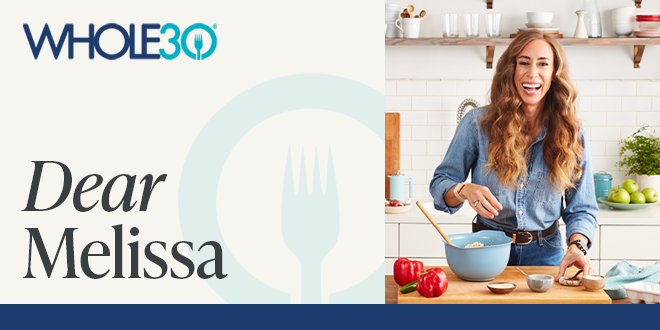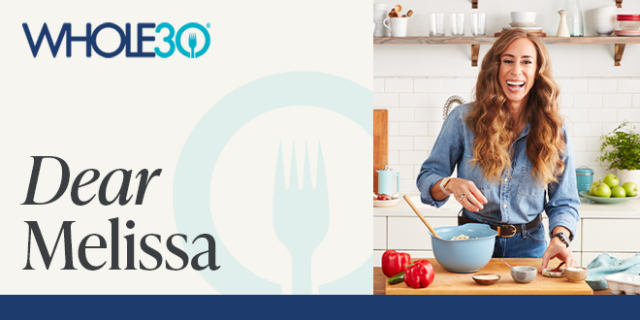Dear Melissa,
I’m on Day 15 of my second Whole30, and I’m wondering if there is such a thing as eating too much dietary fat. Can I cook some eggs in avocado oil and top with hollandaise sauce? Or cook a skillet meal in ghee, but also drizzle it with a Whole30-compatible ranch? The Whole30 Meal Template says 1-2 thumb sized portions of fat per meal, so am I on the right track? -Megan, Calgary, AB
Hi Megan,
Technically, sure, there is such a thing as eating too much dietary fat. Once I drank too much full-fat coconut milk in one sitting, and my digestion paid the price. But I suspect you don’t have to worry about this, for a few reasons. Unless you’re dumping a literal half-bottle of our Whole30-compatible ranch over every plate, you’re doing just fine.
Trust your body’s signals
First, it’s a lot harder to over-eat nutrient-dense whole foods like eggs, avocado and olives than high-fat processed foods like potato chips or French fries. It’s even harder to over-eat if you’re sitting down at the table, chewing slowly and allowing those satiety signals to catch up to your brain. (Compared to wolfing down your drive-through meal in the car between errands.)
Second, the Whole30 helps restore your body’s natural satiety signals, so after a few weeks on the program, you can actually hear (and trust) when your body says, “I’m hungry” and stop eating when you’re full. That’s a lot harder to do with salty + fatty + sweet foods—what I called “food with no brakes” in my first book.
Third, if you do eat too much fat in one sitting, your body will let you know, just as mine did–with delayed hunger signals, gas, heartburn, and other signs of upset digestion. On the Whole30, this usually happens in the context of snacking on roasted, salted nuts and seeds, usually mindlessly. (Think spooning half a jar of almond butter while watching a movie, or snacking on salted cashews right out of the family-sized bag while you’re driving.) It can also happen when you quickly over-consume full-fat coconut milk, like adding half a can or more to a single-serve smoothie, or perhaps when you consume too much of your beloved ranch in a single sitting—although you’d need a lot. However, this doesn’t sound like your context.
Don’t fear dietary fat
Honestly, it’s much more common that people under-eat fat on the Whole30. After years of “fat is bad” messaging coming from health experts and the media, you may still be afraid of dietary fat coming. So many people coming to the Whole30 are conditioned to shop for low-fat everything and use the least amount of cooking oil possible (or those zero-calorie cooking sprays). Because of this, I often see people not eating enough fat (and therefore not enough energy or total calories) during their first Whole30.
On the Whole30, dietary fat is an important part of our meal template. It will keep you satiated and energized between meals, aids in the process of fat adaption (where your body is effectively running on fat as fuel), and helps you preserve muscle mass on the Plant-Based Whole30. In addition, as Chris Traeger so aptly put it in Parks and Recreation, “Things with fat in them taste way better than things with no fat.” Your Whole30 meals should be exciting, flavorful, and satisfying—and fat plays a big role in that.
Added fat on the Whole30
While eating fat as part of a balanced Whole30 meal, you can generally assume that things even out in the wash. As a result of your protein, cooking method, and/or choice of sauce, one of your meals may be higher fat while the next is naturally lower. Plus, some of the cooking fat you use stays in the pan, and if you’re cooking a few servings of meat in one tablespoon of fat (about a thumb-sized portion), you’re certainly not consuming all of it in one serving.
In addition, our recommendations for snacks and mini-meals are to include at least two of the three macronutrients: protein, fat, and carbs. That reduces the chance that you’ll mindlessly snack on that giant jar of almonds you bought at Costco, and thoughtfully put together a snack that includes almonds plus deli turkey plus an apple. This helps you ensure a variety of micronutrients and a healthy balance of macros, too.
However, if you notice that your digestion is off (your stomach cramps or bloats after meals, and you have extra-stinky gas, and/or your stools are soft and oily), or you end up eating so much dressing or dip in one meal that you’re not hungry for the next, keep a closer eye on your fat intake. Try drizzling a serving instead of dumping a cup, making snacks more balanced, and replacing the cashew “queso” on your veggie tray with a cauliflower or sweet potato “hummus.”
For now, if your hunger is appropriate (meaning you’re not overly stuffed after a meal, but not ravenous an hour later), your energy is rockin’ (or getting better), your digestion is smoothing out, and you are feeling satisfied with your food, just keep doing what you’re doing! Most people find by the second week of their Whole30, you’ll be able to trust the signals your body is sending you, including how much to eat.
Best in health,
Melissa















